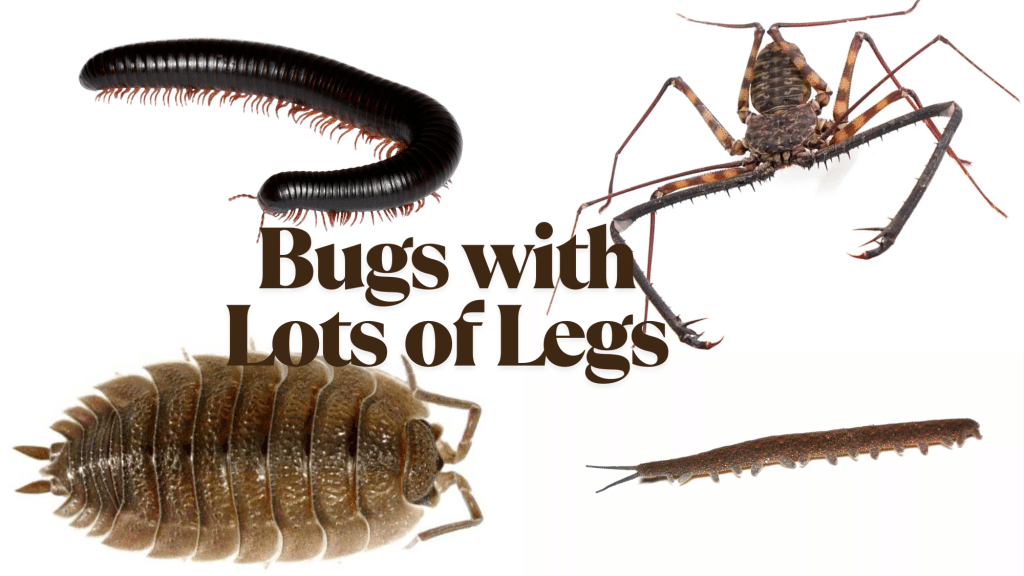Bugs with numerous legs often catch our attention. These small creatures move across surfaces with a speed that can be both interesting and slightly scary.
Starting from common houseworms to millipedes, these multi-legged creatures have adapted to develop in diverse environments worldwide.
And what makes them stand out isn’t just their leg count; it’s how they use those legs to hunt, escape, and survive.
Their bodies have developed over millions of years to perfect these movements.
In this blog, you will learn about the most well-known many-legged insects and arthropods closely.
1. Millipedes
These round-bodied creatures roll into a wooden log when they feel threatened. Millipedes play a crucial role in breaking down plant matter in forests and gardens.
Some species can live up to 10 years in the right conditions and move in a wave-like motion, with their many legs moving in sequence.
Fun Facts
- The word “millipede” means “thousand feet,” though none actually have 1,000 legs
- The record-holder has 750 legs (not 1,000 as their name suggests)
- They clean themselves meticulously, grooming each leg
- Some can spray a mild defensive fluid that smells bad
- Baby millipedes are born with only 3 pairs of legs and grow more as they mature
2. House Silverfish
Silverfish have existed for over 400 million years, making them one of the oldest surviving insects. They are known for their fish-like movements and silver-blue color.
These insects can survive for up to a year without food, but they require moisture to live. They prefer starchy foods like paper, glue, and book bindings. Silverfish shed their skin throughout their entire lives.
Fun Facts
- Silverfish can live up to 8 years
- They can run very fast and stop suddenly
- Silverfish don’t need to mate more than once in their lifetime
- They can sense food from a good distance away
- Female silverfish lay only 1-3 eggs per day, but can lay eggs all year
3. Woodlice (Pill Bugs)
Pill bugs are not insects but small land crustaceans related to crabs and shrimp. They breathe through gill-like structures and need moisture to survive.
When scared, many species can roll into a perfect ball (hence the nickname “roly-poly”). These tiny recyclers are helpful in gardens, breaking down dead plant material and turning garden waste into soil nutrients.
Fun Facts
- They drink through their rear ends
- Mothers carry eggs and babies in a pouch like kangaroos
- They can live up to 3 years
- Their blood is blue, not red
- They eat their waste to recover copper, a vital nutrient for them
4. Scutigera
These fast house hunters catch pests like cockroaches and termites. Unlike most similar creatures, they have compound eyes and good vision.
Their legs get longer toward the back of their body, which helps them run at high speeds. They rarely bite humans, but when they do, it feels like a mild bee sting. And, they have been around for over 300 million years.
Fun Facts
- They can run up to 0.4 meters per second
- They have the longest legs relative to body size in their group
- Their legs can break off if grabbed, and continue to twitch as a distraction
- They clean their legs by pulling them through their mouthparts
- Females lay eggs one at a time and cover each with soil
5. Velvet Worms
With soft, velvety skin and multiple stubby legs, velvet worms look like living fossils. They shoot sticky slime from openings near their heads to catch prey.
Velvet worms hunt at night and hide in moist places during the day. They have changed very little over the past 500 million years. Some species care for their young, which is rare for such ancient animals.
Fun Facts
- They can shoot their slime up to 1.5 feet away
- Some species give birth to live young
- They walk using fluid pressure rather than muscles
- They have skin-like material that can stretch without tearing
- Females of some species eat the males after mating
6. Sea Spiders
These marine creatures have such small bodies that their organs extend into their legs. Sea spiders move very slowly across the ocean floor.
Some species can grow quite large in deep, cold waters. They feed by sucking juices from soft-bodied animals like sea anemones. Their thin bodies let them absorb oxygen directly through their shell.
Fun Facts
- They have no lungs or gills
- Their heart pushes blood only to the front part of the body
- Males, not females, care for the eggs
- Some can grow legs spanning up to 70 cm in polar regions
- They’ve existed for at least 500 million years
7. Whip Scorpions
Despite their scary name, whip scorpions aren’t true scorpions and lack a stinging tail. Their front legs work like antennas to sense the world around them.
When threatened, they spray a vinegar-like liquid, earning them the nickname “vinegaroons.” Whip scorpions dig burrows where they hide during the day. They make good pets because they rarely bite.
Fun Facts
- Their spray contains 85% acetic acid, similar to strong vinegar
- They can live up to 7 years
- Females carry their young on their backs
- They glow blue-green under ultraviolet light
- They clean themselves like cats, using specialized combs on their first pair of legs
8. Jumping Bristletails
These small, wingless insects jump by quickly bending their bodies. They have been around since before the time of the dinosaurs.
With scales similar to those on butterflies, they easily slip away from predators. They prefer damp, dark environments, such as under rocks or in leaf litter. They eat algae, lichens, and plant matter.
Fun Facts
- They can live up to 4 years
- They molt throughout their adult lives, unusual for insects
- They use their tail-like appendages to help them jump
- Some species perform complex mating dances
- They have influenced the design of small robots that can jump
9. Daddy Longlegs (Harvestmen)
Unlike spiders, daddy longlegs have one body section instead of two. They cannot make silk or webs and don’t have venom glands. Their legs contain their sense of smell and taste.
Some species gather in large groups for protection. They eat small insects, plant matter, and even bird droppings.
Fun Facts
- If they lose a leg, it can twitch for up to an hour
- Some species guard their eggs until they hatch
- They’ve existed for over 400 million years
- Their eyes are on a little bump on their body
- Some can detach their legs to escape predators
10. Horseshoe Crabs
These living fossils have remained nearly unchanged for 450 million years. Their blue blood is used in medical testing for harmful bacteria.
Horseshoe crabs flip themselves right-side up with their tails when turned over. They visit beaches in huge numbers to mate during full and new moons.
Fun Facts
- They have 10 eyes spread across their body
- Their blood sells for about $15,000 per quart
- They mate in groups of one female with multiple males
- These can live up to 20 years
- Despite their name, they’re more closely related to spiders than to crabs
11. Lawn Shrimp
These tiny land crustaceans turn bright red when they die, like mini lobsters. They appear in yards after heavy rains force them to the surface from the soil.
Lawn shrimp breathe through gills and will dry out quickly in the sun. They feed on decaying plant matter in moist soil. Although they may appear concerning, they’re harmless to humans and pets.
Fun Facts
- They’re less than 1/4 inch long
- They hop like fleas when disturbed
- They can enter homes through tiny cracks, but die quickly indoors
- These turn your fingers pink if you handle them
- They’re found worldwide but are native to Australia and the Tasmanian regions
From the forest to the ocean depths, these many-legged bugs show just how unusual and creative life can be. Some shoot slime, others glow under UV light, and a few even drink through their rear ends. Isn’t it amazing?So, the next time you spot one moving by, take a closer look and let us know in the comments section below!


























